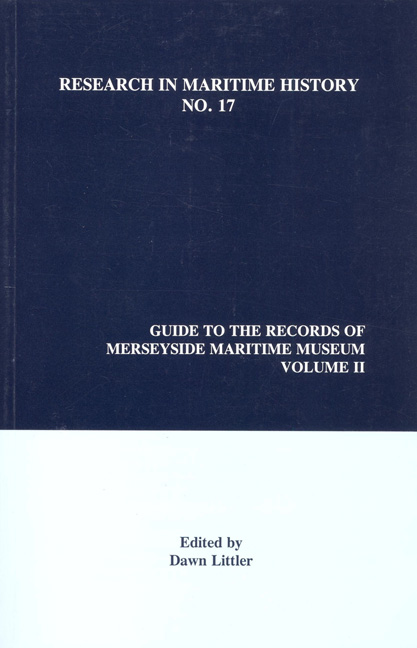Book contents
- Frontmatter
- Contents
- Introduction
- Notes on Access and Use of the Archives
- Acknowledgements
- Notes on the Editor
- List of Illustrations
- Chapter 1 Merchants, Ship Brokers and Agents, Stevedoring and Warehousing Companies
- Chapter 2 Transatlantic Slavery and Slave Trading
- Chapter 3 Emigration
- Chapter 4 Maritime Charities, Missions and Educational Establishments
- Chapter 5 Shipbuilding and Repairing, Engineering and other Maritime Trades
- Chapter 6 Maritime Families
- Chapter 7 Seafarers and Other Individuals
- Chapter 8 Special Collections: Titanic and Lusitania
- Chapter 9 Pictorial and Audio
- Chapter 10 Maritime Library
- Chapter 11 Research, Miscellaneous and Non-Maritime
- Chapter 12 Addenda to Guide, Volume I
- Index
Chapter 9 - Pictorial and Audio
- Frontmatter
- Contents
- Introduction
- Notes on Access and Use of the Archives
- Acknowledgements
- Notes on the Editor
- List of Illustrations
- Chapter 1 Merchants, Ship Brokers and Agents, Stevedoring and Warehousing Companies
- Chapter 2 Transatlantic Slavery and Slave Trading
- Chapter 3 Emigration
- Chapter 4 Maritime Charities, Missions and Educational Establishments
- Chapter 5 Shipbuilding and Repairing, Engineering and other Maritime Trades
- Chapter 6 Maritime Families
- Chapter 7 Seafarers and Other Individuals
- Chapter 8 Special Collections: Titanic and Lusitania
- Chapter 9 Pictorial and Audio
- Chapter 10 Maritime Library
- Chapter 11 Research, Miscellaneous and Non-Maritime
- Chapter 12 Addenda to Guide, Volume I
- Index
Summary
The Merseyside Maritime Museum holds a wide range of pictorial and audio records, and these can be divided into the following categories: maps, charts, dock plans and drawings, ship's plans, photographic records, postcards, film, video and audio tapes. Much of the material is embedded in larger collections, notably that of the Mersey Docks and Harbour Board. This chapter is a brief summary of the scale and content of these records and at the time of writing, we have to admit that not all of this material has been listed in full. Given the size of many of these collections, their locations and varied degree of cataloguing, it is advisable to check availability before your visit.
There are also other sources of pictorial material in the Museum's collections. These are the oil paintings, watercolours, drawings, posters and prints curated by the Maritime History Department. The paintings have been collected to represent the work of the Liverpool marine painters of the late eighteenth and nineteenth centuries. The ship portraits provide detailed information about the individual appearance of ships before photography and as many of the backgrounds are of Liverpool and the Mersey, provide detailed topographical evidence. Other works include views of Liverpool which show how the town and port developed from the late seventeenth century. They include the first authentic view of Liverpool painted in 1682 and the Buck brothers' engraving of 1728 which shows all the new developments including the first dock opened in 1715. Much of the best of this collection is on show in the Art and the Sea gallery and there is a catalogue of the oil paintings. There are also a notable collection of ship bows, early nineteenth century prints and a growing collection of passenger liner posters. In addition, the collections of the Museum of Liverpool Life contains pictorial material on life inland of the port and the City Record Office has a major collection which covers all aspects of the city.
Maps
The MDHB collection contains the widest selection of Ordnance Survey maps because as a port authority, it had an interest in the coastal and estuarial margins, which stretched from the upper Mersey to Anglesey. The collection is not comprehensive. Its main value lies in the large number of the two largest scales: 1/2500 and 1/1250.
- Type
- Chapter
- Information
- Guide to the Records of Merseyside Maritime Museum , pp. 175 - 184Publisher: Liverpool University PressPrint publication year: 1999



